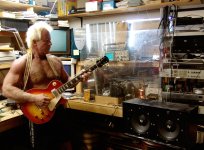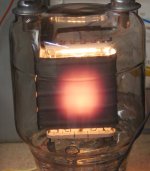Any tube has a plate/anode resistor, of course. Even power tubes do. How can you tell that the plate resistances in a PP circuit are equal without measuring? Especially in not too sophisticated output transformers the DC resistances of both primary halves aren't equal, hence plate voltages of 200 vs. 182 V, as Jan mentioned, aren't that unrealistic.No you are wrong again. Power tubes never use an anode resistor. I did not state a tube has an internal anode resistor. No power tubes have an internal anode resistors. I will not reply to your posts now.
Ergo, Jan was right, you're wrong.
Btw, most important thing that counts in tube operation is the plate current. Why don't you just measure it if you're about matching tubes?
Best regards!
No power tube has a plate resistor, only preamp tubes. A power tube would not work with a plate resistor. Bad advice folks.
Everybody, Kay Pirinha states power tubes use a plate resistor, even stated internal plate resistor. He does not know the difference in a power tube and preamp tube.
Last edited:
Yes. Bias voltage within say 0.5v for the entire quad. You seem to be in denial that you are posting nonsense. Moving on...100s of degrees difference with same bias and voltage? You mixing NOS and used tubes? Some of your tubes are barely operating and others maxed out. In fact, impossible on same construction tubes that are NOS. I point temperature gun at top of tube.
Thank you - I'll get back and warn the others.Everybody, Kay Pirinha states power tubes use a plate resistor, even stated internal plate resistor. He does not know the difference in a power tube and preamp tube.
Indeed. Manufacturers have had 100 years to put something about temperature into their datasheets and their complete silence on the topic says it all. The only reference I can think of will be to the possible forced cooling of transmitter tubes, but I'm guessing 99% of us don't run our own radio stations.
Maybe those who DO use a tube from an AM radio station just choose to broadcast at a lower than intended frequency. Note the glowing 833A in the background behind the Lexan "oops shield."
Thue 833A data sheet does discuss the heat in the metal / glass interface around the pins. That is the area of concern on large glass transmitter tubes. The coated plate is the getter and redness is recommended for proper operation. This tube was dissipating about 400 watts at idle and cools off when the guitar is cranked to way beyond eleven! One can guess the vintage of the photo by the CRT TV and computer monitor. It's from 2003.
Thue 833A data sheet does discuss the heat in the metal / glass interface around the pins. That is the area of concern on large glass transmitter tubes. The coated plate is the getter and redness is recommended for proper operation. This tube was dissipating about 400 watts at idle and cools off when the guitar is cranked to way beyond eleven! One can guess the vintage of the photo by the CRT TV and computer monitor. It's from 2003.
Attachments
That might be a good idea - I can't see anything useful coming out of this.
Jan
Jan
One is overlooking that a power tube has an anode resistor in the form of the output device...output transformer ....antenna...tank coil....................................
exception might be a cathode follower.
exception might be a cathode follower.
I often find that a useful way of exploring a subject is to turn an argument on its head.
Rather than thinking that tubes are matched because they run at the same temperature, one can ask oneself why some of them were running at different temperatures.
If some of those factors add to the temperature and some of them reduce the temperature, then it may become apparent that a similar temperature might be possible not only by matching, but also by coincidence.
kind regards
Marek
Rather than thinking that tubes are matched because they run at the same temperature, one can ask oneself why some of them were running at different temperatures.
If some of those factors add to the temperature and some of them reduce the temperature, then it may become apparent that a similar temperature might be possible not only by matching, but also by coincidence.
kind regards
Marek
There is an interesting article on diyAudio projects that describes different output configurations. Some may find germane to the topic in this thread.Everybody, Kay Pirinha states power tubes use a plate resistor, even stated internal plate resistor. He does not know the difference in a power tube and preamp tube.
It's all context. For high power amplifiers it is common to use what would normally considered a power tube as the preamp for the final tube.
You see even 300B's used as preamp/driver tube.
Whether you use a tube for a preamp or power amp output depends on the tube capabilities and the needed output power.
Tubes are normally designed for a specific purpose and the data sheet will mention that. But you, as a designer, can use it any way you want, if you know what you are doing. You can (and many do) use, say, a voltage regulator tube as an amplifier output tube.
Apart from the basic fact that if you don't have any anode impedance you have no signal output so that's a pretty useless circuit.
For an output tube in a headphone amp, an anode resistor might well be a good solution.
In larger power amplifiers you can do better with an inductive load (like in a single ended amp) or an output transformer in a P-P amp.
So, saying that power tubes do not have anode resistors is a very narrowminded view which greatly restricts your options.
A similar situation exists in the solid state world. For phono preamp input stages you normally want a transistor with very low Rbb for very low noise contribution. It just so happens that many power transistors have extremely low Rbb and it is not unusual to see a phone input stage using a large power transistor.
Dogmatism is never a good idea if you want to explore design space. Keep an open mind and venture into the world of audio design!
Jan
You see even 300B's used as preamp/driver tube.
Whether you use a tube for a preamp or power amp output depends on the tube capabilities and the needed output power.
Tubes are normally designed for a specific purpose and the data sheet will mention that. But you, as a designer, can use it any way you want, if you know what you are doing. You can (and many do) use, say, a voltage regulator tube as an amplifier output tube.
Apart from the basic fact that if you don't have any anode impedance you have no signal output so that's a pretty useless circuit.
For an output tube in a headphone amp, an anode resistor might well be a good solution.
In larger power amplifiers you can do better with an inductive load (like in a single ended amp) or an output transformer in a P-P amp.
So, saying that power tubes do not have anode resistors is a very narrowminded view which greatly restricts your options.
A similar situation exists in the solid state world. For phono preamp input stages you normally want a transistor with very low Rbb for very low noise contribution. It just so happens that many power transistors have extremely low Rbb and it is not unusual to see a phone input stage using a large power transistor.
Dogmatism is never a good idea if you want to explore design space. Keep an open mind and venture into the world of audio design!
Jan
You can also add these to the list:-
Futterman/white cathode/output transformerless (OTL) circuits
direct driving an electrostatic
ZOTL
hybrid tube/FET outputs
kind regards
Marek
Futterman/white cathode/output transformerless (OTL) circuits
direct driving an electrostatic
ZOTL
hybrid tube/FET outputs
kind regards
Marek
Actually, I'd say what we now call a transformer is really no more than two wirewound resistors sitting on top of a magnet. If there were just one of them, we'd call it a choke.Output transformer is not an anode resistor.
Faraday invented the "transformer" in 1831. He called his invention "an induction coil". The term "transformer" only came into common usage much later in 1883 and is derived from the French.
Last edited by a moderator:
- Home
- Amplifiers
- Tubes / Valves
- Matching tubes by Operating Temperature


